Chunky Newborn Beanie Pattern
/Soft and chunky newborn beanie with a fluffy ball on top! This crochet pattern works up really quickly and easily!
Read MoreSoft and chunky newborn beanie with a fluffy ball on top! This crochet pattern works up really quickly and easily!
Read MoreStep by step tutorial with pictures to make this simple girls dress out of knit fabric. I can be made with a contrasting panel or sheer lace across the shoulders.
Read MoreMake these easy fabric bows with a step by step sewing tutorial. They can be made in any size and the tails can be shortened for hair bows.
Read More
Make a doll maxi skirt with these simple tutorial. You can make a whole bunch of these from old t-shirts or knit scraps. It has a foldover yoga waistband.
Read More

When my 5yo got her own "fake American Girl doll" for her birthday, she immediately began nagging incessantly for a doll dress to match her Flutter Sleeve Sundress. Since I made them for her sisters, it was only fair, so I whipped one up as soon as I got a chance.

She loves it! Again, I took pictures this time since I didn't have a deadline and could sew in the daylight hours, so you are getting a tutorial! YAY!
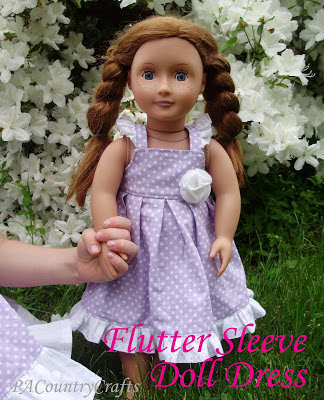
I made a pattern for you (again, this is for personal, non-commercial use only and don't sell this pattern, please and thank you). You can download the pdf pattern HERE.
For the bottom ruffle and side ties, cut two strips 2" by the width of the fabric (about 44"). Cut one of those strips in half. The bottom ruffle will take 1 1/2 strips. Take the remaining half strip and cut that in half. Those are your side ties.
This is all of the pieces:
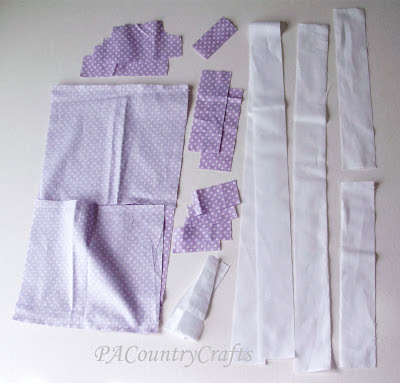
Let's start out with the straps. I used a rolled hem edge on the ruffles, so if you don't have a serger, you can cut them a bit wider and do a small folded hem instead. I sewed a long, gathering stitch along the bottom edge.
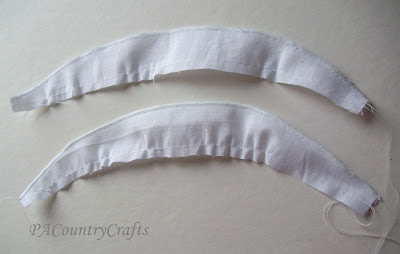
To make the straps, press the fabric like you are making double-fold bias tape. Press the long edges to the center, then press again to fold it in half.
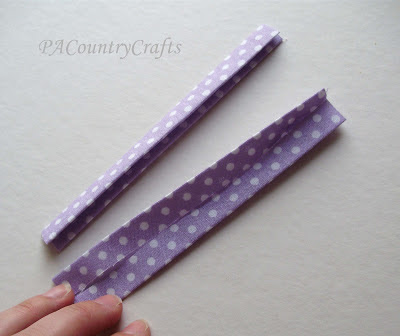
Gather the ruffles and sandwich them into the straps with pins. I left a little extra room on the ends in this pic, but the ends of the ruffles should be about 3/8" from the edge of the strap.
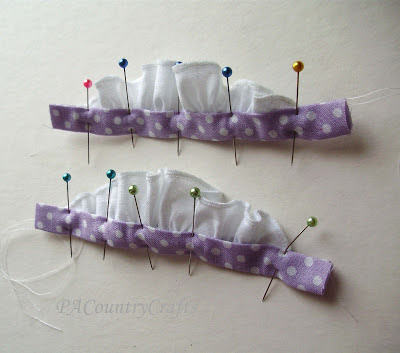
Sew about 1/8" or less from each side to attach the ruffle and topstitch. It looks so professional this way!
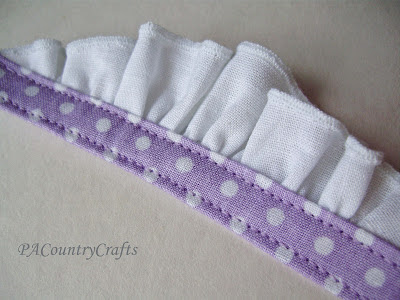
Pin the straps to the bodice, sandwiching them between the front and back pieces and leaving 1/4" seam allowance to the corners.
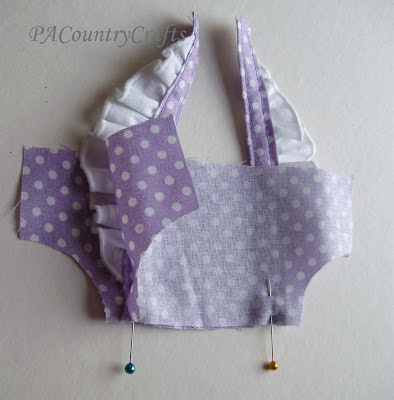
Clip the curves, flip, and press.
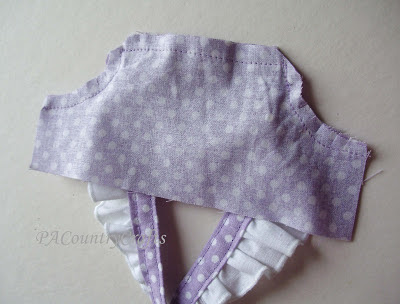
Attach the straps to the back pieces the same way. The strap should be about 1" from the inside edge of the back and angled slightly as shown. (I left one of the back pieces off for the picture so that you can see the angle- they should be sandwiched when you sew it.)
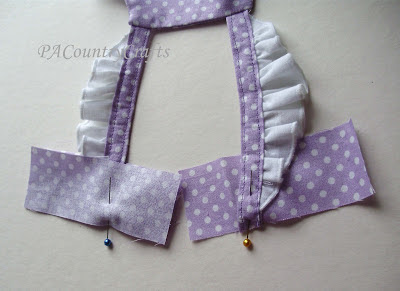
Make the side ties by sewing right sides together, flipping, and pressing neatly.
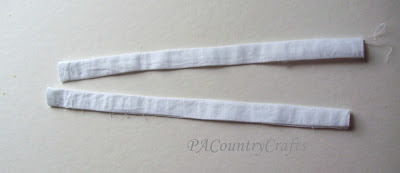
I topstitched all the way around and hemmed the ends, too. I just didn't take a picture of that. Now, I skipped some pictures here, but all you have to do is pin the straps into the sides 1/2" above the bottom edge and then sew the sides together. I serged them for more stability, too. Then, I totstitched all the way around the edge of the bodice. Sorry, I know that is a lot at once.
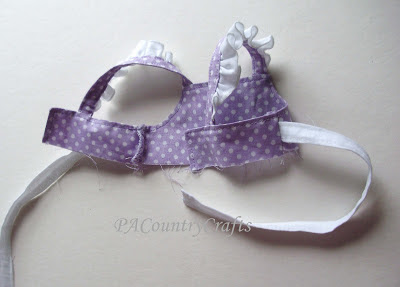
OK, for the skirt portion of the dress... sew the sides together and sew up the back center seam, leaving the top 2" open. Overlock or zig-zag over the raw edges.
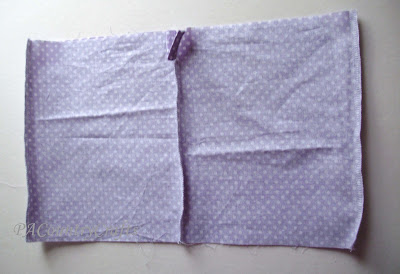
Make a button placket to cover the opening. I am not going into detail on that part because I already did that HERE if you need help.

Then, just make your pleats using good ol' trial and error and pin the skirt to the top, right sides together.

Sew and overlock or zig-zag the raw edge and topstitch in place on the bodice about 1/8" above the skirt.
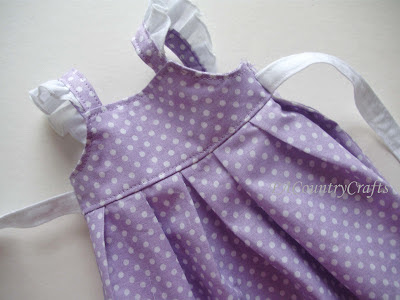
Almost done! Make the bottom ruffle by sewing the two pieces together and hemming the bottom edge. I was playing with my new machine and made a fancy stitch here.

Gather and sew it to the bottom edge of the skirt. Overlock or zig-zag stitch over the edge and then topstitch it in place.

Insert a snap in the back...
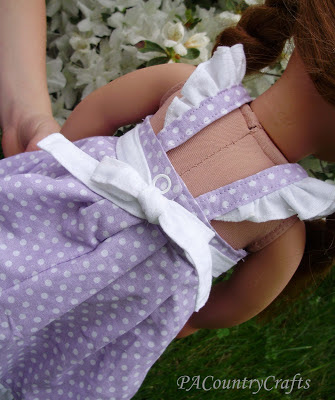
...and make a little felt flower for the front.

TADA!

It made her so happy!

It makes me very happy that Grace isn't old enough to ask for a doll and matching dress for her Little Diva Dress though. I loved all those ruffles, but a doll is not worth that much effort to me. I want to make her a matching purse instead, since she loves purses right now.
So, my 5yo wanted to take a picture of all of the dolls together...

From left to right... Twirly Lace Doll Dress, Flutter Sleeve Doll Sundress, and Boutique Peasant Doll Dress.
If you make a dress using one of these patterns, I would love to see it! If you have any questions, just send me an e-mail. :)
Here are some more doll dress patterns you might like:

I was surprised that so many people were interested in the pattern for this dress! So, I redrew it from my scribbled up copy and copied all of the measurements onto the same paper. Here ya' go! The downloadable pdf pattern is available HERE. (Updated 3/20/16)
If you have trouble, please just e-mail me at pacountrycrafts at gmail dot com and I will send you a copy of the pattern.
I hope this helps! The directions are in the original tutorial HERE. If you make one I would just LOVE to see it!
Again, this pattern is for your own, personal, non-commercial use. Please do not copy the pattern and sell it yourself. (As my 5yo would say, "Don't you know? That is actually rude!" Kinda' makes me wish I could upload sound on here for you to hear just how funny it sounds coming from her.)
Happy sewing! I hope I can help make some other little girls just as happy as mine were!
Sewing, crafts, tutorials, recipes, and a little look at our life in the country - raising half a dozen children.

Hi! Thanks so much for stopping by! My name is Lindsay and on this blog you will find sewing, crafts, decorating, recipes, and tutorials with a little bit of honesty and encouragement.